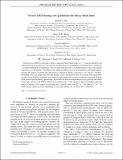Precise LIGO lensing rate predictions for binary black holes
Author(s)
Ng, Ken K. Y.; Wong, Kaze W. K.; Broadhurst, Tom; Li, Tjonnie G. F.
DownloadPhysRevD.97.023012.pdf (496.0Kb)
PUBLISHER_POLICY
Publisher Policy
Article is made available in accordance with the publisher's policy and may be subject to US copyright law. Please refer to the publisher's site for terms of use.
Terms of use
Metadata
Show full item recordAbstract
We show how LIGO is expected to detect coalescing binary black holes at z>1 that are lensed by the intervening galaxy population. Gravitational magnification, μ, strengthens gravitational-wave signals by √μ without altering their frequencies, which if unrecognized leads to an underestimate of the event redshift and hence an overestimate of the binary mass. High magnifications can be reached for coalescing binaries, because the region of intense gravitational-wave emission during coalescence is so small (∼100 km), permitting very close projections between lensing caustics and gravitational-wave events. Our simulations use the current LIGO event-based mass function and incorporate accurate waveforms convolved with the LIGO power spectral density. Importantly, we include the detection dependence on sky position and orbital orientation, which for the LIGO configuration translates into a wide spread in observed redshifts and chirp masses. Currently, we estimate a detectable rate of lensed events 0.06[superscript +0.02][subscript -0.02] yr[superscript -1] that rises to 5[superscript +5][subscript -3] yr[superscript -1] at LIGO design sensitivity limit, depending on the high redshift rate of black hole coalescence.
Date issued
2018-01Department
Massachusetts Institute of Technology. Department of Physics; LIGO (Observatory : Massachusetts Institute of Technology); MIT Kavli Institute for Astrophysics and Space ResearchJournal
Physical Review D
Publisher
American Physical Society
Citation
Ng, Ken K. Y., et al. “Precise LIGO Lensing Rate Predictions for Binary Black Holes.” Physical Review D, vol. 97, no. 2, Jan. 2018. © 2018 American Physical Society
Version: Final published version
ISSN
2470-0010
2470-0029